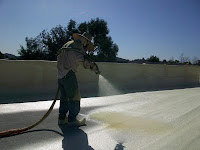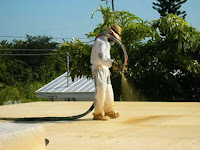 Any roof inspection should look at the roof, but the roof surface is only one item that should be checked.
Any roof inspection should look at the roof, but the roof surface is only one item that should be checked.
The first thing to look at is your files. Do you have all of the paperwork you need? How about a copy of the warranty? Do you have the names and phone numbers of the companies that have been involved with the roof — previous inspectors, roofing contractors, architects, manufacturer technical services? You should have a copy of all the repair orders and the results of the repairs made. Finally, there should be a roof plan, drawn to scale, that not only shows all the equipment on the roof, but also the locations of any leaks and any repairs made.
The walls and glazing should also be checked. Too many times leaks from wall, sealant and window failures are disguised as "roof" leaks. Look for cracks and water stains that may be symptomatic of problems in these areas. The worst offenders are pipes, conduit and other penetrations through the walls. Too often these are left unsealed, especially when they are installed as retrofits.
Once those steps have been taken, you are ready to look at the roof. The best place to start is with an overall look at the roof. Is it covered in debris, like leaves, plants and old air conditioning equipment? This is a sure sign that the roof has been neglected. Look at the surface of the roof. If there is a coating, is it intact? If there is gravel or ballast, are the rocks evenly distributed and covering the whole surface?
The surface of the roof provides protection from ultraviolet radiation from the sun, which causes most roofing materials to age and break down. It's like your skin. If you don't give yourself UV protection, your skin ages prematurely and sometimes with serious results.
You should also check the drainage system. If there are large areas of standing water that never seem to go away, it may be possible to solve the problem simply by removing the gunk from around the drain. Or you may need to snake the roof drain pipes or down spouts. Standing water can lead to premature failure of the roof as the water may leach the chemicals that keep roofs pliable out of the membrane. Worse still, if there is a puncture in an area of standing water, what should have been a minor drip becomes a major disaster as all of that standing water ends up inside the building.
Roof failures rarely start in the large expanses of field membrane. Any roof check should pay special attention to the membrane and metal at changes in plane and at penetrations through the roof. First, make sure the surfacing is intact. Look for punctures, tears and scrapes in the membrane. Check for unsealed laps both in the vertical part of the flashings and also where the flashing terminates on the field of the roof. Make sure the membrane is not drooping. This is a symptom that the flashing was improperly installed — either it wasn't fastened properly at the top, or it was not properly adhered to the wall or curb. If you see diagonal wrinkles in the flashings, you have a situation where the roof deck and the wall are moving independently. These wrinkles will end up as cracks in the flashings and ultimately as leaks.
If you have expansion joints running across your roof, include them in the inspection. Some roofing contractors don't terminate expansion joints correctly and, as a result, the expansion joints crack at the ends. Check the rubber bellows for cuts and open laps and also for "repairs" done with roofing cement or other inappropriate materials.
If penetrations such as pipes and equipment stands are waterproofed with metal or plastic pitch pans or concrete rings, check the sealer to be sure that it is not cracked and that the pan or ring is completely filled with the sealer. Check the bottom of the concrete ring to be sure the seal between the ring and the roof membrane is still sealed. Check alternate flashings such as prefabricated metals or plastic or rubber boots for cracks, holes and failed sealants.
Find a Contractor
Find a Contractor
Tired of labor problems and low profit margins?
Make more $$ spraying coatings with Conklin Roofing Systems!
Patton Services | (309) 303-3128 | rpatton55@comcast.net | http://www.whiteroofingsystems.com
Make more $$ spraying coatings with Conklin Roofing Systems!
Patton Services | (309) 303-3128 | rpatton55@comcast.net | http://www.whiteroofingsystems.com

















